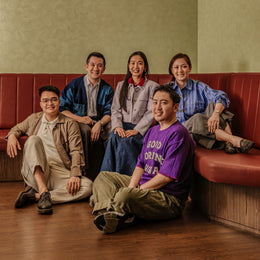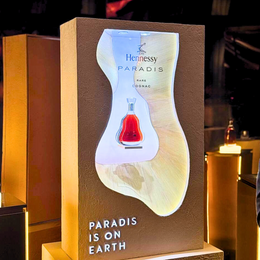We Fell In Love With Dining Out All Over Again at temper.: The Amber-Lit Temple to Wine Conceived by Spain’s First Master Sommelier

Roberto Durán quietly stood alone between rows stacked from floor to ceiling. Cool lighting hummed over bottles, neatly slotted in their places. The man looked up and down the aisle, turning slowly from one side to the other as he rubbed his hands and murmured inaudibly to himself, almost absentmindedly – as if rehearsing for a wine presentation, or perhaps engaged in a dialogue with old friends, asking which one might volunteer itself for the table. Minutes passed, but he remained in that narrow aisle, lost in thought. He was in no hurry to decide. For a moment, the glass room felt less like a state-of-the-art wine cellar and more like a personal chapel for Roberto.
I have to admit, I surreptitiously snapped this quick photo of him last month when I had the opportunity to visit temper., as Roberto pondered in the cellar. He didn’t notice, of course, completely absorbed in thought (If you’re reading this, Roberto, I hope that was okay!)


Many following Singapore’s wine and drinks scene have been genuinely excited about temper. as one of the most anticipated openings of the year. Not just for its large scale cellar which boasts over 1,200 wine labels with 250 available by the glass – but also for the all-star team behind it.
Helming the wine programme here is one other than Roberto Durán MS – who happens to be Spain’s first ever Master Sommelier, and one of only three currently based in Singapore. For context, the Master Sommelier designation is the world’s most rigorous and prestigious accolade in wine service; fewer than 300 people worldwide hold it. Before temper., Roberto is known in the city for leading the wine programme at 67 Pall Mall Singapore.

Then there’s the cocktail side, curated by consulting bartender June Baek, whose name you might recognise from Madame Fan and MO Bar. A winner of multiple cocktail competitions, June truly made her mark as a star for developing the signature drinks at the Mandarin Oriental Singapore’s MO Bar – helping it debut on The World’s 50 Best Bars 2021 and later climb to No. 8 on Asia’s 50 Best Bars 2022, earning the Nikka Highest Climber Award that year.

Completing the triptych is a culinary programme shaped by Executive Chef Nicolas Tam and Head Chef Ronald Sim – the former of Michelin-starred Willow fame, the latter trained at Burnt Ends and Candlenut. Together they’ve built a menu that matches the ambition of the beverage programme, drawing from fine-dining technique without losing the comfort of shared plates.

Head Chef Ronald Sim (Left) and Executive Chef Nicolas Tam (Right).
With a lineup like this, you can see why temper. has stirred such anticipation. There’s something here for everyone – wine aficionados, cocktail lovers, and diners seeking refinement without pretension.

There’s a theatricality to how the space reveals itself. Step through the entrance and we first pass through a vestibule of marble and wood panels before emerging into an open wine bar and kitchen framed by sculptural mid-century lines. Velvet seating and wood panels soften the acoustics, while the lighting casts a flattering, amber glow designed for date nights. Beyond that, a climate-controlled glass room showcases the wine cellar like an installation piece.
Down a grand flight of stairs lies the spacious but intimate lounge, reminiscent of a Milanese aperitivo bar garnished with a touch of 1970s futurism. The soundtrack – curated by Head of Programming Josh Pillai, formerly of CE LA VI, KU DE TA, and Mandala Club – moves from soul, jazz, R&B to funk. The result is a space with polish but not stiffness: somewhere that serious wine enthusiasts can relax, and cocktail regulars can enjoy a touch more sophistication than usual.

When you ask for the wine list, you’re handed an iPad, a digital catalogue that mirrors the breadth of their cellar. I’m not a heavy drinker, but I like variety, so I naturally gravitated to the wines by the glass. It’s a both deep and curious selection that spans renowned Old World producers: classic Burgundy domaines, classed-growth châteaux from both banks of Bordeaux, and a range of prominent grower Champagnes. There are also thoughtful inclusions from less-expected regions including Greece, China, South America.
To start, Roberto poured us a welcome glass of Meunier varietal Champagne from Champagne Denis Salomon, a fifth-generation grower-producer. The wine was distinctly terroir-driven – light, mineral, slightly bready on the nose, with supple fruit and a fine, persistent bead. On the palate it showed ripe orchard fruit, soft texture, a touch of almond, and a clean, saline finish. Crisp, rounded, and quietly expressive – the kind of Champagne that opens your palate and wallet.

The next glass Roberto poured was an atypical white wine from Loire. The Ronceray 2022 from Château de Plaisance is a 100% Chenin Blanc that hails from the Chaume–Quarts-de-Chaume area of the Loire Valley, a region more traditionally known for its sumptuously sweet dessert wines. Yet this bottle was made dry – and that, in itself, makes it rather unique.

“Ronceray” is relatively new term. It refers to a new generation of dry wines crafted within the Chaume and Quarts-de-Chaume appellations – areas historically reserved for sweet botrytised Chenins.
Château de Plaisance itself sits in Rochefort-sur-Loire, within the Anjou district, cultivating vines rooted in the schist bedrock of the “Butte de Chaume”. These ancient, fractured soils are notoriously tough – hard, well-drained, and mineral-rich – forcing the vines to dig deep for water and nutrients.
This naturally stresses the vines and concentrates flavour, while the schist imparts a distinct tension and minerality to the wine, something that becomes more apparent by Plaisance’s decision to vinify dry. In a way, “Ronceray” represents a quiet revolution in the Loire – a return to terroir expression stripped of residual sugar, to allow the land to speak a little louder.
The 2022 Ronceray Ch de Plaisance opens with a bright, crystalline nose, with tart white fruits, sappy orchard notes, fresh peaches, citrus zest and the faint nuttiness of marzipan. There’s a whiff of grape skins and a subtle saline edge that evokes crushed seashells and wet stone. It unfolds gently on the palate: mellow acidity, a very textural interplay with whisper of oak joined by fruit and minerality. Rather than dazzling with overt fruit, it captivates with subtlety and balance. There’s a nice harmony between restrained fruit, minerality, texture and acidity.
The first red wine was ruby-toned and vividly aromatic. Roberto initially poured this blind for us and wouldn’t give us any hints besides letting on that it was an Old World wine from somewhere near a volcano. It turned out to be the Mavrotragano 2020 from Vassaltis, a boutique family-run winery perched on the volcanic slopes of Santorini.

Mavrotragano (from mavro meaning “black” and tragano meaning “crisp”) is one of those ancient Greek grape varieties that was nearly extinct but successfully revivedin the late 20th century by a handful of visionary winemakers – including Vassaltis – who saw in it the potential to produce serious, age-worthy reds on an island more famous for its whites.
Traditionally, Santorini was known almost exclusively for its white wines made from Assyrtiko, the flagship variety that thrives in the island’s arid, windswept soils. But Mavrotragano, with its small, thick-skinned berries and firm tannins, offered a contrasting narrative – one of depth, structure, and volcanic fire.
What makes Santorini such a compelling terroir is its volcanic “aspa” soil, a mix of pumice, ash, and lava rock that is completely phylloxera-free and inhospitable to disease. These mineral-rich soils, combined with intense sun and dry Aegean winds, yield naturally low yields and wines that possess a distinctive salinity and smoky minerality.
The Vassaltis 2020 Mavrotragano opened with an expressive, almost heady bouquet – potpourri, ripe red fruits, sun-warmed plums, and a touch of bramble, framed by aromatic oak and gentle vanilla. On the palate, it revealed a supple, medium-bodied texture, ripe fruit giving way to cocoa, dry herbs, and a faint volcanic smokiness.
The tannins were youthful and firm, with a confident grip, while a thread of bright acidity lifted the richness and kept it precise.
After about an hour in the decanter, it began to unfold with more layers of red fruit, spice and earth. What I loved most was its tactileness and duality: that interplay between Santorini’s mineral tension and the Mediterranean warmth of ripe fruit and warm oak. This would undergo a decade or more of graceful evolution.
The next glass Roberto poured for us came blind once again – no hints, no clues, only his faint smile as we swirled and guessed. I took a sip and immediately thought: Pinot Noir from Burgundy. It had that same translucent ruby hue, the perfume of red berries, the supple frame, and that fine-boned tension. But once again, Roberto proved us wrong. This wasn’t from Burgundy at all – it was from another volcano, this time Mount Etna in Sicily, Italy’s fiery south. The wine was the Rosso di Mezzo 2022 by Federico Graziani.

Federico Graziani is both the man and the label: a former top Italian sommelier who made the leap from serving wines to crafting them. Graziani earned his sommelier certification at just 19 and went on to work with some of Italy’s finest restaurants and wine programs. But his passion for Etna drew him to the land. He founded his eponymous estate on the northwestern slopes of Mount Etna, where vineyards climb as high as 1,200 metres above sea level.
The soils here are remarkable, with a patchwork of volcanic ash, lava rock, and black sand. These mineral-rich but poor soils, combined with Etna’s extreme day–night temperature shifts, create conditions that push the vines to their limits.
Graziani, with his sommelier’s training, chooses to highlight those qualities: his approach to winemaking is low-intervention, using native yeasts, minimal sulphur, and little new oak, all in service of drinkability, elegance and purity of terroir.
Rosso di Mezzo is his single-vineyard Etna Rosso. The Etna Rosso DOC is known for red wines that often invite comparison to Burgundy for their grace and perfume, but with a distinctive smoky minerality that can only come from volcanic soil. The grape behind this, Nerello Mascalese, is a thin-skinned, late-ripening variety which produces pale-coloured wines with high acidity and finely grained tannins – structurally reminiscent of Pinot Noir or Nebbiolo.
The 2022 Rosso di Mezzo opened with bright, pure notes of crushed strawberries, raspberries and pomegranate, lifted by hints of incense, pencil shavings, and a delicate twist of orange peel. On the palate, it was medium-bodied and racy, with crisp, transparent red fruit and a light but tactile tannic structure. A trace of sweet citrus, orange and lemon zest, flickered at the back, followed by a faint whisper of ash, iron, and freshly turned soil that should have given its identity away to me.
This is one of the more compelling examples of a well-structured Etna Rosso which you could drink it now for its freshness and vitality, or wait perhaps another couple of years to let its minerality and structure unfold into something more profound.

There’s also the food. And when the food is this well executed, the pairing almost feels effortless. temper.’s kitchen appears to focus on simple things done really, really well. It reminds me of Marco Pierre White’s exhortation to young chefs: “Keep it simple. Don’t overwork it.”
The Denis Salomon Champagne found its perfect companion in the Red Shrimp Carpaccio, a translucent sheet of sweetness balanced by citrus oil and sea salt. Its supple mousse and soft acidity gently lifted the natural oceanic note of the raw shrimp, accentuating the freshness. The pairing extended effortlessly to the Seafood Tower, a sculptural stack of oysters, Dungeness crab, mussels. I was genuinely impressed by the freshness of the seafood.

Then came something hearty – a Wagyu Blend Burger, seared golden and packed with juice, served alongside fries that were unapologetically crispy and seasoned just right.
When the Federico Graziani Rosso di Mezzo came around, its herbal lift and vivid red fruits immediately found harmony with the Iwate Striploin, served with a glossy reduction of beef jus and a minty chimichurri. It’s got such a thick crust thanks to the use of a Josper oven (a specialty Spanish charcoal grill-oven hybrid that applies intense heat). The result is remarkable: a Maillard-rich savoury crust while the interior stays medium rare and tender. The red’s acidity and mineral backbone slices neatly through the richness of the steak.

It was also a graceful match for the grilled Turbot, crisp-skinned with buttery flesh and resting in a silky pil-pil sauce (a kind of Basque-style emulsion coaxed from fish collagen and olive oil). Alongside this, the Uni Linguine was indulgent but balanced. The sauce creamy but not heavy, the sea urchin lending just enough creaminess and sweetness to keep you reaching for the next bite.
There’s nothing overly complicated about it, and that’s exactly why it works. It’s neither fussy or high-concept; it wins you over with how natural and well-prepared everything tastes, with nothing feeling out of place and everything incredibly easy to share. It’s the kind of cooking and pairing that reminds you why people fall in love with eating out all over again. Good wines and good food done right.

After the wines, we moved on to cocktails – which at temper. are on the more straightforward, easy-drinking side. There’s no overcomplication or showmanship here; the focus is on balance and flavour rather than elaborate presentations. Each drink feels like something you could enjoy on a regular night out, not just a special occasion.

My favourite was the Poppy Den. It’s smooth and velvety, lightly sweet, with the gentle smokiness of Ardbeg 10 running through the mix. The peat doesn’t overpower. Instead, it blends naturally with the watermelon, lemon, rose and ginger, giving the drink both freshness and depth. It’s garnished with what look like purple poppy petals, a small nod to Duxton’s opium-linked past that gives the cocktail its name.
Coda
So that was my first experience at temper. I should add that several weeks after that media tasting, I couldn’t stop thinking about the place, so when a Swiss friend visited the city, I immediately suggested temper. for dinner and wine. This time, I went for an easy classic – a pour of Château Rauzan-Ségla 2015.

It’s not every day you find a fine Second Growth served by the glass, and that’s something temper. deserves praise for, for being willing to open such bottles and trust its clientele to appreciate them. This time, my drinking partner and I were very well taken care of by Sommelier Yue Chow, whose enthusiasm made the experience even more enjoyable.
On the nose, the wine was lusciously aromatic and evocative with brambly fruit intertwined with plum, dark cherry and cassis, rounded off by a faint whiff of graphite and cigar box earthiness. There was a perfume of violets and dried rose petals, too, unmistakably Margaux.
The palate was concentrated but graceful. Rich red and black fruits filled the mid-palate, framed by a judicious touch of new oak that lent structure without overshadowing the fruit. Acidity had mellowed beautifully with time, being soft and integrated, while the tannins were fine-grained and cashmere-like in texture. Beneath that polish, a core of earthy minerality kept the wine grounded. The finish unfurled with slate, dark chocolate, coffee grounds and a whisper of vanilla, laced with soft spices and lingering plummy richness. It was elegant, balanced, and quietly powerful, with that restrained confidence typical of great Left Bank vintages.
What struck me was how remarkably alive the 2015 still felt. Compared against a younger vintage from the early 2020s which I’ve recently tasted, I found the 2015 every bit as vibrant. It’s evident that this is poised to age gracefully, well into the 2030s.

Great wines feel perfectly at home at temper., among the quiet hum of conversation, the soft-lit lighting, and the gentle clinking of glasses. Here are evenings where the service, setting and selection all seemed to hum in the same elegant key.
temper. sits within the Mondrian Singapore hotel, tucked into the end of Duxton Hill road. It’s open every day except Sundays, a small mercy that lets the tireless team take a breather. With a collection that spans more than a thousand labels, there’s always something new to discover. Whether you’re returning to revisit a favourite pour or chasing the next surprise, I can personally attest that temper. rewards repeat visits.

@CharsiuCharlie






